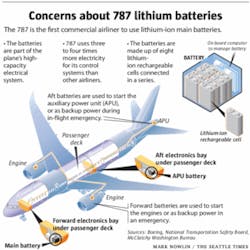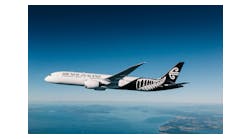Jan. 24--In 2006, a devastating lab fire in Arizona showed just how volatile Boeing's 787 Dreamliner lithium-ion battery can be if its energy is not adequately contained.
A single battery connected to prototype equipment exploded, and despite a massive fire-department response the whole building burned down.
On the finished Dreamliner, however, Boeing is confident its engineers can safely harness and contain that energy.
The 787's battery-fire protection regime aims both to make a catastrophic blowout impossible through multiple independent controls and also to compartmentalize any less serious battery meltdown, venting smoke outside until the high-temperature reaction burns itself out.
That approach was approved by the Federal Aviation Administration (FAA), with special conditions attached.
Yet the All Nippon Airways (ANA) 787 emergency last week suggests Boeing's containment plan -- even if the engineering is technically solid -- may not work for airlines in operational terms.
In the ANA incident, the pilot made an emergency landing when he received warnings of an overheated battery and smelled a burning smell in the cockpit.
"If I've got an unexplained source of smoke or smell and messages indicating an overheat or a fire has been detected, frankly, I'm not going to pull out the book," said veteran airline captain and aviation expert John Nance. "I'm just going to get the ship on the ground."
Unless such events will occur only very rarely, Boeing's engineering solution won't be tenable as a practical matter.
Two 787 battery incidents in quick succession out of 18,000 in-service flights so far isn't close to rare enough. That's why the jet fleet is grounded worldwide as investigations continue.
The Air Line Pilots Association (ALPA) raised concerns about Boeing's battery-fire-protection plan in the course of the FAA certification process.
During the public-comment period in 2007, the pilots union stressed that "a fire from these devices, in any situation, is unacceptable."
ALPA quoted a 2006 FAA report on transporting lithium-ion batteries as cargo, which concluded that a relatively small amount of heat is sufficient to cause the flammable chemical inside a lithium-ion cell -- called an electrolyte -- "to forcefully vent ... through the relief ports near the positive terminal."
"The electrolyte is highly flammable and easily ignites when exposed to an open flame or hot surface," the FAA report added.
People familiar with the investigation so far confirm that electrolytes sprayed out of the battery in the ANA jet, leaving a dark sooty residue across the electronics bay. Photos show the insides of the battery burned out and blackened.
The 787 carries two large lithium-ion batteries.
One in a rear electronics bay is used mainly to start the plane's auxiliary power unit; the other in a forward bay is used to start the main engines.
In an emergency, the two batteries provide backup power for flight-control electronics and emergency lighting.
The forward electronics bay that housed the malfunctioning ANA battery is like the "brains" of the airplane, filled with critical flight-control equipment.
Extinguishing fires
In its 2007 comments, the pilots union initially asked that the FAA require "means for extinguishing fires" caused by the lithium-ion batteries.
However, in a subsequent email to the FAA later that year, the union switched gears and asked that the focus be "preventing a fire and not reacting to one."
ALPA did not respond to requests for comment Wednesday.
In any case, the FAA decided not to require fire suppressant in the electronics bay, and Boeing didn't include it.
Mike Sinnett, Boeing vice president and chief 787 project engineer, explained why in a conference call last week and detailed Boeing's engineering solution.
To completely rule out any catastrophic high-energy fire or explosion that could result from overcharging a battery, Sinnett said, Boeing designed four independent systems to monitor and control the battery charge.
However, he conceded that if an internal cell shorts and overheats, "the electrolyte can catch on fire and that can self-sustain."
"Something like that is very difficult to put out," Sinnett said. "Because the electrolyte contains an oxidizer, fire suppressants just won't work."
Boeing's design solution is to contain that outcome until the combusting battery cell or cells burn out.
"You have to assume it's not going to go out," Sinnett explained. "You have to assume that it's going to go and that it's going to expend all of its energy.
"You have to be good with the amount of heat and smoke that's generated from that event," he added.
Sinnett pointed out that the air flow in the electronics bay will be redirected when smoke is detected, so that the smoke is vented overboard, not into the passenger cabin or cockpit.
Nance, the veteran pilot, said he assumes Boeing's engineers have got that right -- in which case, it's possible the incident on board the ANA jet played out as they intended.
But still, he said, Boeing "may not have adequately planned for the number of potential incidents" that might occur during a jet's lifetime.
Calculating how often this kind of event might happen requires knowledge of the root cause of this month's battery incidents. The cause, or causes, remain unknown.
If it was a bad batch of batteries, the number of malfunctions could be reduced with higher quality control in the manufacturing plant.
If it's something inherent in the battery design, Boeing may be forced to switch from lithium ion.
At least aviation-safety regulators appear close to ruling out, if not yet definitively, the worst-case scenario of a potentially explosive overcharging:in the two recent incidents.
Japanese aviation-safety regulators said Thursday that the overheated battery aboard the ANA Dreamliner flight last week didn't seem to be overcharged.
Their U.S. counterparts concluded the same about the battery that caused a fire on a Japan Airlines Dreamliner in Boston the previous week.
Battery testing
The potential dangers of the 787's lithium ion batteries were made vividly apparent in a 2006 incident when a single battery ignited during testing in a lab run by Securaplane Technologies of Tucson, Ariz.
While Japanese company GS Yuasa manufactures the Dreamliner batteries, Securaplane makes the charging-control system. Both components are integrated into the overall electrical system by Thales of France.
During testing of a prototype charging-system design in the 2006 incident, "the battery caught fire, exploded, and Securaplane's entire administrative building burned to the ground," according to a summary by the administrative law judge in a related employment lawsuit.
The ruinous fire resisted the initial efforts of two employees with fire extinguishers, and escalated, despite the dispatch of a fleet of fire trucks, to destroy the 10,000-square-foot building.
It reached temperatures of about 1,200 degrees and resulted in losses of millions of dollars.
The cause of the battery explosion was not firmly established. The battery may have been overcharged, and human error in the testing was not ruled out. Indeed, Boeing insists it was an improper test setup.
However, a local fire district's summary lists one of three possible causes as "a battery malfunction due to the batteries [sic] composition."
And, apparently referring to the same possibility, the legal summary in 2011 says one possible cause is "a defect in a small corner of a cell."
The FAA investigated the Securaplane incident in 2008 and 2009.
"The investigation determined that the battery-charging units in the complaints were prototypes, and none are installed in Boeing 787 aircraft," the FAA said in a statement in response to questions about the incident.
Sinnett, Boeing's 787 engineering chief, said the company is ready to deal with the investigation's conclusions and adjust its design accordingly.
"Information will come in, we'll challenge our assumptions, and if we need to make some changes, we'll make those changes and we'll move on," he said.
Dominic Gates: 206-464-2963 or [email protected]
Seattle Times staff reporter Steve Miletich contributed to this report.
Copyright 2013 - The Seattle Times





